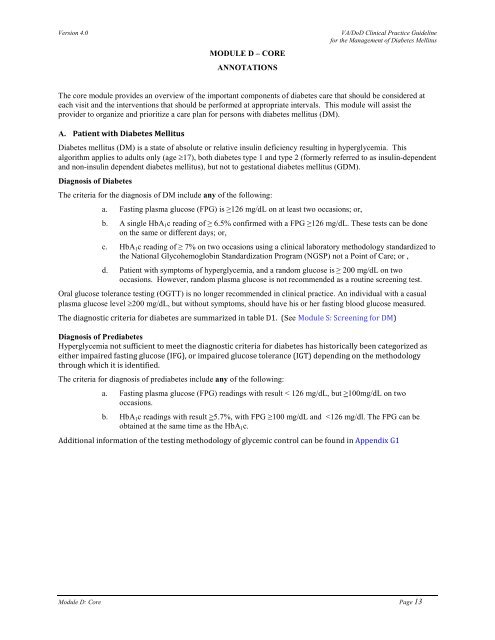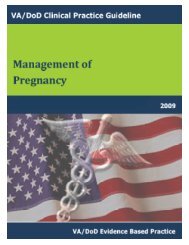DM Full Guideline (2010) - VA/DoD Clinical Practice Guidelines Home
DM Full Guideline (2010) - VA/DoD Clinical Practice Guidelines Home
DM Full Guideline (2010) - VA/DoD Clinical Practice Guidelines Home
Create successful ePaper yourself
Turn your PDF publications into a flip-book with our unique Google optimized e-Paper software.
Version 4.0<br />
MODULE D – CORE<br />
ANNOTATIONS<br />
<strong>VA</strong>/<strong>DoD</strong> <strong>Clinical</strong> <strong>Practice</strong> <strong>Guideline</strong><br />
for the Management of Diabetes Mellitus<br />
The core module provides an overview of the important components of diabetes care that should be considered at<br />
each visit and the interventions that should be performed at appropriate intervals. This module will assist the<br />
provider to organize and prioritize a care plan for persons with diabetes mellitus (<strong>DM</strong>).<br />
A. Patient with Diabetes Mellitus<br />
Diabetes mellitus (<strong>DM</strong>) is a state of absolute or relative insulin deficiency resulting in hyperglycemia. This<br />
algorithm applies to adults only (age ≥17), both diabetes type 1 and type 2 (formerly referred to as insulin-dependent<br />
and non-insulin dependent diabetes mellitus), but not to gestational diabetes mellitus (G<strong>DM</strong>).<br />
Diagnosis of Diabetes<br />
The criteria for the diagnosis of <strong>DM</strong> include any of the following:<br />
a. Fasting plasma glucose (FPG) is ≥126 mg/dL on at least two occasions; or,<br />
b. A single HbA 1 c reading of ≥ 6.5% confirmed with a FPG ≥126 mg/dL. These tests can be done<br />
on the same or different days; or,<br />
c. HbA 1 c reading of ≥ 7% on two occasions using a clinical laboratory methodology standardized to<br />
the National Glycohemoglobin Standardization Program (NGSP) not a Point of Care; or ,<br />
d. Patient with symptoms of hyperglycemia, and a random glucose is ≥ 200 mg/dL on two<br />
occasions. However, random plasma glucose is not recommended as a routine screening test.<br />
Oral glucose tolerance testing (OGTT) is no longer recommended in clinical practice. An individual with a casual<br />
plasma glucose level ≥200 mg/dL, but without symptoms, should have his or her fasting blood glucose measured.<br />
The diagnostic criteria for diabetes are summarized in table D1. (See Module S: Screening for <strong>DM</strong>)<br />
Diagnosis of Prediabetes<br />
Hyperglycemia not sufficient to meet the diagnostic criteria for diabetes has historically been categorized as<br />
either impaired fasting glucose (IFG), or impaired glucose tolerance (IGT) depending on the methodology<br />
through which it is identified.<br />
The criteria for diagnosis of prediabetes include any of the following:<br />
a. Fasting plasma glucose (FPG) readings with result < 126 mg/dL, but ≥100mg/dL on two<br />
occasions.<br />
b. HbA 1 c readings with result ≥5.7%, with FPG ≥100 mg/dL and
















